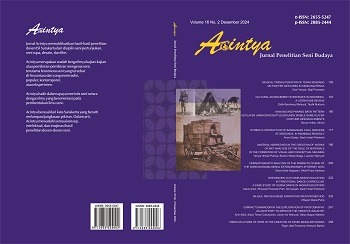COMPACT DARKROOM IN THE EXPLORATION OF PHOTOGRAPHY AS AN EFFORT TO IMPROVE THE CREATIVE INDUSTRY
DOI:
https://doi.org/10.33153/acy.v16i2.6766Keywords:
darkroom, experiment, photogramAbstract
Using a darkroom to create photogram works often gives rise to findings related to the effectiveness and efficiency of using light in the enlarger in the darkroom as well as findings to deal with problems that exist when in the darkroom. This then inspired the desire to carry out an experiment that would be useful when researchers carried out the photogram technique, but could be done outside the dark room. Through this research, it is hoped that the aim will be to obtain a solution to the problems that the researcher stated in the previous paragraph. In this applied research efforts are made to apply the research results which can be used to develop creative photography experiments, especially the photogram technique. The darkroom is an important space that must exist in the analog era. A dark room is a room that is literally dark with several devices such as enlargers and chemicals that are used for the image development process. The darkroom or darkroom is a manifestation of the development of the camera obscura in the 18th century. Portable darkrooms became very popular among artists/photographers because of their practicality in being able to travel with them, or dark-room wagons which were usually attached to a horse-drawn carriage or stroller. It is hoped that this research can provide a useful solution in terms of ease and practicality in carrying out photogram techniques so that the illumination process can be carried out outdoors (not in a dark room) so that it has more value as when using a conventional camera.
Downloads
References
Astiti, A. (2021). HAND-COLOURING PADA MULTIPLE EXPOSURE PHOTOGRAM. Acintya : Jurnal Penelitian Seni Budaya. https://doi.org/10.33153/acy.v13i1.3845
Astiti, A., Pratmajaya, P. L., & Setiawan, A. H. (2022). ASPEK TATA KELOLA CAHAYA UNTUK MEMPENGARUHI EFEK VISUAL FOTOGRAM. Acintya Jurnal Penelitian Seni Budaya. https://doi.org/10.33153/acy.v14i2.4546
Eperjesi, Á. (2021). The Photogram as a Medium of Art and Education. Theatron. https://doi.org/10.55502/the.2021.4.20
Gunantra, I. M. W. P., Candrayana, I. B., & Octaviano, A. L. (2021). IMAJINASI POTRET WAJAH WANITA DALAM FOTOGRAFI EKSPRESI DENGAN TEKNIK PHOTOGRAM. Retina Jurnal Fotografi. https://doi.org/10.59997/rjf.v1i1.326
Irwandi, Andrea, N. J., J.S., M. S., & Maulana, R. (2022). Perancangan Studio Keliling Fotografi Analog Sebagai Sarana Pendidikan Dan Hiburan. Rekam: Jurnal Fotografi, Televisi, Animasi.
Kurniawan, A., Hariyanto, H., & Wisesa, A. M. (2022). Dampak Limbah Pakaian terhadap Lingkungan sebagai Konsep Penciptaan Karya Fotografi Seni. JoLLA: Journal of Language, Literature, and Arts. https://doi.org/10.17977/um064v2i92022p1238-1254
Marien. Mary Warner. (2011). 100 Ideas That Changed Photography. Laurence King Publishing.
Muñoz-Franco, G., Criado, A. M., & García-Carmona, A. (2020). Investigating Image Formation with a Camera Obscura: a Study in Initial Primary Science Teacher Education. Research in Science Education. https://doi.org/10.1007/s11165-018-9721-z
Pangestu, P., & Widayati, S. (2016). Aplikasi Teori Dasar Fotografi Berbasis Mobile. Jurnal Ilmiah KOMPUTASI (Komputer & Sistem Informasi).
Prasetya, A. D. D. (2021). PENGHAWAAN DAN PENCAHAYAAN ALAMI. Jurnal Ilmiah Arsitektur. https://doi.org/10.32699/jiars.v11i1.1876
Rusli, E. (2017). IMAJINASI KE IMAJINASI VISUAL FOTOGRAFI. REKAM: Jurnal Fotografi, Televisi, Dan Animasi. https://doi.org/10.24821/rekam.v12i2.1426
Soedjono, S. (2007). Pot Pourri Fotografi. Universitas Trisakti.
Tell, V. (2019). Photograms and screens. Images through the lens of words and words through the lens of images. Fotocinema. https://doi.org/10.24310/Fotocinema.2019.v0i18.5531
Downloads
Published
How to Cite
Issue
Section
License
Copyright (c) 2025 Anin Astiti, Setyo Tohari Caturiyanto, Johan Ies Wahyudi, Setyo Bagus Waskito

This work is licensed under a Creative Commons Attribution 4.0 International License.
Author continues to retain the copyright if the article is published in this journal. The publisher will only need publishing rights






